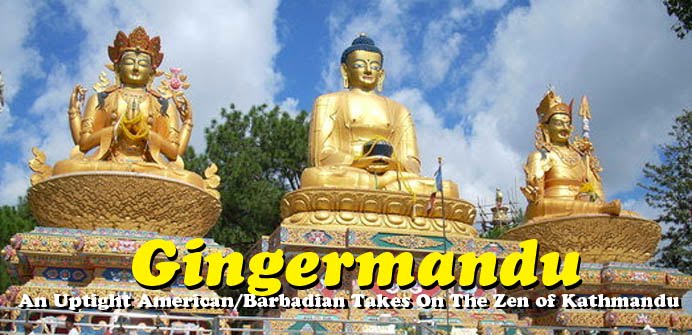My friend Del said, "tell us more about the temples." Well Del, I am not smart enough, nor eloquent enough, to properly describe my first experiences with the temples and stupas in the Kathmandu area. And while I have only seen a few, too few to wax elaborately about the subject, I am struck by the differences and the commonalities they share.
The Kathmandu area has three areas named Durbar Square: Kathmandu, Bhaktapur and Patan. My first weekend here, my better half and I took the one-hour drive to Bhaktapur. The drive out of the chaos of Kathmandu—on a Saturday, the official day of rest here—was no less frantic as any other day in the city. But our driver, Sujendra, suggested Saturday the best day to travel the short distance. The area in and around Bhaktapur used to have very fertile land, and in its prime was full of farmland. Now, the dusty and dirty road that takes you to Bhaktapur has a few “gardens” scattered along the road. These gardens are no doubt fertilized by not only the dust and dirt from the roads, but also from the gas and oil that spill from the exhausts and motors of the vehicles that travel these tributaries. But the farmers, many dressed in red, tend to them as if they were crafting bonsai trees. They squat and till and weed and even wipe the dirty leaves of the rows of green shooting up from the land.
We arrived in Bhaktapur early morning, paid our fee to enter the city (it is a working city where people live among these temples), said “yes” to a local guy who wanted to be our tour guide (for a fee) and started our journey back into time. The Durbar Square is actually several squares, all of which contain their own temples and shrines to various Gods that are worshiped. The temples in Bhaktapur have elaborate woodcarvings and sculptures at adorn the windows, doors, roofs and walls and are thousands-of-years old. Many are guarded by large stone animals. [Mary Campbell, if you are reading this, cover your eyes!] Early in our two-hour tour, and the only time our “guide” left us to examine a temple without his running commentary, was at one particular X-rated shrine. Here were 51 windows (one for each of the King's wives) and some of the most explicit erotic art, chiseled in large pieces of wood, this side of cyber porn. I think my favorite were the erotic elephant “positions.”
A running commentary from our “guide” was about the absolutely stunning stonework or woodwork inside and around the temples. On several occasions he would add as a footnote: “When this was completed the King ordered the hands of the craftsman be chopped off so he could never again create such beauty.” Talk about penis envy.
The temple squares also have large “baths” where the locals would bathe. The King, being the King and all, had has own private bath that is adorned with a golden cobra. Today, I noticed that the baths are used as places to hang clothes and fabrics for drying in the hot sun. Bhaktapur is also the city where once-a-year animals are sacrificed during a particular festival. I read about this festival this year in our local newspaper as a certain animal rights organization was protesting the “heinous” act. As it was being explained to us, well as weird as it might sound to you, it made sense. This is their religion, not my religion. And I cannot and will not fault nor condemn something that has been practiced for thousands of years. (That is the Baptist rebelling.) Non-Hindus cannot enter the temple where this is done, and only Hindus can enter on special occasions. A guard stands watch with a gun in case someone was to make a mad dash into the scene of the crime.
Ok, the temples and the sculptures and monuments are stunning and breathtaking and awe-inspiring. I will not even attempt to describe them to you. Other than to say this city is made up of a lot of wood and some metal and stone. You don’t see the gold and the vibrant colors here that you see at some of the other temple areas. What you see evokes peace and reflection. And compared to Durbar Square in Kathmandu (more on that later) it is as quiet as a library.
Bhaktapur is a tranquil place where potters fill a square and turn their clay on giant wheels. Where men sit and chisel pieces of wood and craft amazing works of art. Where small old women spin wheels of cotton that will be made into sweaters and handbags and hats and countless other items tourists will take home with them. Where dogs lie in the sun, locals sell their wares and visitors marvel at a place where time stands still.
When I come down off my high I will tell you about my Saturday adventure to The Monkey Temple…a place I was initially forbidden to go…a place where my better half and I spent his birthday!
Namaste
Subscribe to:
Post Comments (Atom)

Wish I could be there to sketch "elephant positions"!
ReplyDelete